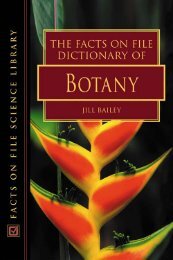Create successful ePaper yourself
Turn your PDF publications into a flip-book with our unique Google optimized e-Paper software.
The cell wall<br />
Plant protoplasts are normally enclosed by a wall<br />
(2.3, 2.4) which gives rigidity and protection to<br />
the cdl but, unless impregnated with fany materials,<br />
does nOt prevent water and solutes diffusing<br />
across it to the plasmalemma. The walls of<br />
adjacent cells are cemented together by a common<br />
middle lamella (2.11, 2.12) so that plant cells are<br />
immobile, although fibres and some other cells<br />
elongate by tip growth and intrude ben"een the<br />
neighbouring cells.<br />
Following cell division the progeny usually<br />
undergo vacuolation growth and theiT primary<br />
walls also expand. Commonly in parenchymatOlls<br />
tissue the middle lamellae break down at the sites<br />
where several cells connect to each other and<br />
intercellular spaces develop (2.59). When expansion<br />
growth ceases some cell types undergo deposition<br />
of a secondary wall (2.7 to 2.10). The<br />
constitution of the secondary wall components<br />
and (he orientation of its cellulose microfibrils<br />
(2.60) is markedly differenr from that of the<br />
primary wall.<br />
Primary wall<br />
Cytokinesis normally immediately follows mitosis<br />
and so the two progeny are divided by a common<br />
cell plate (2.25). The plate first appears at the<br />
equator of the mitoric spindle (2.56) and then<br />
advances centrifugally (2.56 to 2.58, 2.61) ro fuse<br />
with the mother cell wall. The plare is formed<br />
from fusing dicryosome vesicles (2.53) and is<br />
delimited by a plasmalemma derived from the<br />
dictyosome membranes (2.57, 2.58). Strands of<br />
ER penetrate the plate and these form the central<br />
dcsmotubular component of the plasmodesmata<br />
(2.13,2.14) which connect the proroplasts of<br />
adjacent cells. The unrhickened cell plate constitutes<br />
the middle lamella common to both<br />
daughter cells (2.57, 2.58). It is largely composed<br />
of pectic substances and subsequently a thin<br />
primary cell wall is deposited on both surfaces of<br />
the plate (2.12, 2.15).<br />
When a highly vacuolated cell divides, the<br />
growing margins of the cell plate are marked by<br />
dense cytoplasm (the phragmosome, 2.61) in<br />
which dusters of shorr microtubules occur (1.56<br />
to 2.58). In some tissues mitosis is not immediately<br />
followed by cell plate development: in the<br />
endosperm of many species the initially coenocytic<br />
cytOplasm (2.5) later becomes divided by freelyforming<br />
walls. These often develop in a tortuous<br />
pauern and a similar phenomenon occurs in callus<br />
tissue (1.62). In transfer cells tortuous invaginations<br />
of the primary wall into the protoplast occur<br />
(2.63) and such modifications of parenchyma cells<br />
are common adjacem to vascular elements.<br />
30<br />
In thinner areas of the wall plasmodesmata are<br />
often clustered together (2.2). with up to 60<br />
present per square micrometer of wall surface, to<br />
form pit fields (2.64). When secondary wall<br />
deposition occurs, these regions often remain<br />
unthickened and give rise to pits closed internally<br />
by a pit membrane (primary wall, 2.10, 2.54,<br />
2.65). Where lignification of the wall occurs, it<br />
largely restricts the passage of water and nutrients<br />
benveen protoplasts to the non-lignified pitted<br />
regions (2.10).<br />
In the tracheary elements of the protoxylem<br />
(2.9) a lignified secondary wall is deposited<br />
internal to the primary walls in discrete rings or a<br />
spiral, but extensive tracts of non-lignified<br />
primary wall lie between the thickenings. These<br />
non-lignified regions are attacked by hydrolytic<br />
enzymes released from the vacuole of the<br />
degenerating protoplast, so that frequently only<br />
the cellulosic skeleton ('holey' wall) remains in the<br />
mature element to indicate the original position of<br />
the primary wall (2.66).<br />
The somewhat thickened walls of sieve tubes<br />
(2.6). and the thick walls of many storage<br />
parenchyma cells (2.54) are primary and do nOt<br />
normally undergo lignification. During differemiation<br />
of the sieve e1emems their protoplasrs<br />
largely degenerate (2.67), leaving intact the<br />
plasmalemma together with modified plastids<br />
(2.68, 2.69), mitochondria, endoplasmic reticulum<br />
and deposits of P-protein (2.67, 2.68). The end<br />
walls of the sieve elements become modified as the<br />
amorphous polysaccharide, callose, is deposited<br />
within the wall around (he plasmodesmata (1.6,<br />
2.67). The desmotubular component of the<br />
plasmodesma disappears and eventually a wide<br />
pore develops, ranging from 1-15 ).1m in diameter,<br />
but this usually appears plugged in sectional<br />
material (2.6, 2.68).<br />
The primary wall contains up to 80% of irs<br />
fresh weight as water, while the other componems<br />
are predominantly polysaccharide. Biochemical<br />
analysis shows thar cellulose constitutes 25-30%<br />
by weight of the dried wall while hemicelluloses<br />
constitute a further 15-25%, pectic substances up<br />
(035%, and glycoproteins 5-10%.<br />
Cellulose is a polymer of glucose with units<br />
linked into long unbranched chains of up to<br />
15,000 monomers. These are laterally hydrogenbonded<br />
to form microfibrils (2.17, 2.70) several<br />
micrometres long and 3.0-8.5 nm wide. The<br />
microfibrils possess high tensile strength and<br />
reinforce the wall in a form analogous to steel<br />
rods in reinforced concrete. The other polysaccharide<br />
components are non-fibrillar. It is<br />
considered likely that the hemicelluloses are linked<br />
to the microfibrils by hydrogen bonding. In turn<br />
the hemicellulose is covalently attached to a





